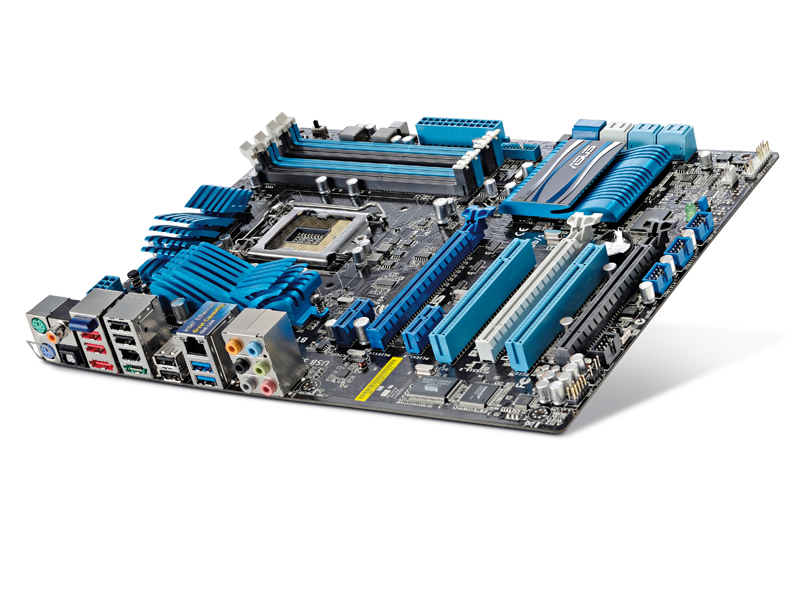TechRadar Verdict
Capital performance and features, but the B3 revision shouldn't cost this much more.
Pros
- +
Great CPU performance
- +
Capable overclocker
- +
Handy Bluetooth BIOS control
Cons
- -
Price boost
- -
Less comprehensive settings than Maximus IV Extreme
Why you can trust TechRadar
Overview
For those that have kept up with the motherboard scene lately, the release of the Asus P8P67 Pro might look like old news. It was in fact originally released in January, in parallel with Intel's Sandy Bridge chips hitting the market.
On release it seemed a pretty solid socket 1155 board to pair with the new range of CPUs, but then Intel went and announced "technical issues" with its 6-series chipset (codenamed Cougar Point), which affected SATA II ports and caused long-term degradation of SATA devices. Cue massive recall, widespread pandemonium, skies turning a deep crimson and the dead walking the earth... Alright, just the recall. But still.
The Asus P8P67 Pro B3 is technically an issue-proof motherboard. The 'B3' refers to the chipset revision. It offers the exact same features of the original P8P67 Pro, only the SATA issue is fixed. Why the devil then, is it so much more expensive now?
The mark-up of B3 boards extends beyond Asus to just about any manufacturer with a socket 1155 board on the market. It's not right to point fingers without being able to establish who initiated it, but at a consumer level it's plain unfair.
Features
Soapbox time over. It's sturdy enough, supports four-way discrete GPU arrays and a huge chunk of RAM without making too much of a fuss of its visual design. No zany heatsink designs here, just diligent cooling.
Super-fast connectors of the USB 3.0 and SATA 6Gbps variety are available if not abundant, sporting four of the former and two of the latter. In short, it has all the features you'd expect from a sub-£200 board. There are a few pleasing extras, though.
First, there's the EFI BIOS you'll find with any Sandy Bridge chipset. It makes the BIOS screen look friendlier, recognises boot devices of over 2TB and adds mouse support.
Sign up for breaking news, reviews, opinion, top tech deals, and more.
The P8P67 Pro's settings aren't quite as comprehensive as its big brother the Maximus IV Extreme, but there are sufficient overclocking options to squeeze a large glass of extra performance juice from your CPU, either by tweaking global multiplier settings or through Turbo ratios (if you have an unlocked K series chip).
On test
Asus's Maximus IV Extreme RoG is a fine board, if a bit of a mouthful. Little brother P8P67 Pro B3 is, as little brothers so often are, keen to mimic big bro's performances.
Considering the price difference, it comes damn close. These figures are stock. Overclocked, it comes even closer.
Video encoding performance
X264 v2: Frames per second – higher is better
Asus P8P67 Pro B3: 32
Asus Maximus IV: 35
CineBench 10: seconds – quicker is better
Asus P8P67 Pro B3: 38
Asus Maximus IV: 35
DX10 gaming performance
WiC: Frames per second – higher is better
Asus P8P67 Pro B3: 95
Asus Maximus IV: 96
Verdict
We were able to run our 2600K at a stable 4.5GHz with the Pro B3, which is commendable for this end of the price spectrum.
The Bluetooth receiver is a nice touch too, allowing remote overclocking via your smartphone or tablet. Value for money, then, is the premium consideration here, albeit with a few perks. If we ignore that earlier rant about the B3 revision mark-up, this board delivers truckloads of the stuff.
Performance is comparable to the flagship Maximus IV in terms of CPU grunt and gaming, and there's a huge wad of cash separating the two.
Unfortunately, the inflated price means we can't quite recommend this as much as we'd like to. With the imminent release of Z68 chipsets that offer the best of both current H67 and P67 boards, it makes more sense to hold out a bit longer before buying the ideal home for your Sandy Bridge chip.
Follow TechRadar Reviews on Twitter: http://twitter.com/techradarreview

Ad creative by day, wandering mystic of 90s gaming folklore by moonlight, freelance contributor Phil started writing about games during the late Byzantine Empire era. Since then he’s picked up bylines for The Guardian, Rolling Stone, IGN, USA Today, Eurogamer, PC Gamer, VG247, Edge, Gazetta Dello Sport, Computerbild, Rock Paper Shotgun, Official PlayStation Magazine, Official Xbox Magaine, CVG, Games Master, TrustedReviews, Green Man Gaming, and a few others but he doesn’t want to bore you with too many. Won a GMA once.
